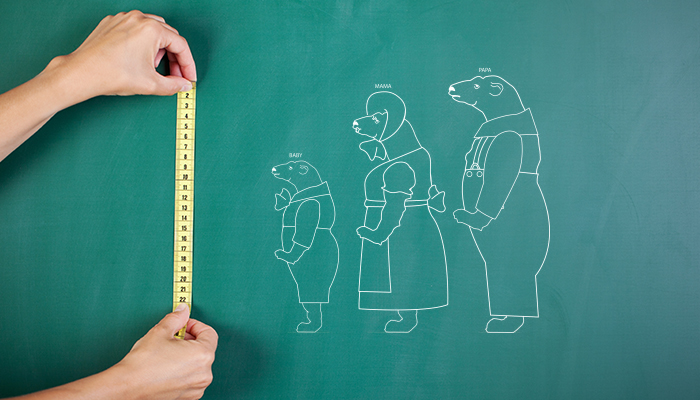If ergonomists were looking for a mascot, my vote would go to Goldilocks−yes, I mean the blonde chick with a poor sense of boundaries. I’ve been working in the field of ergonomics for more than 10 years, and lately, I’ve begun to feel a certain kinship with the story-book character from my childhood days.
Let me explain: a few months ago I was helping a colleague assess the ergonomics of her work station; she had recently moved to a new department, and was suffering from neck stiffness and pain. After a taking a few measurements, I was able to verify that her desk and chair were set too high for her stature. Once the work surface was lowered, I invited her to try out a variety of office chairs, and a few minutes later I heard her exclaim, “This one’s just right!” that’s when it hit me: Goldilocks is all about ergonomics.
You know how the story goes: our heroine wanders into the house of the three bears while they’re taking a walk in the forest and proceeds to break several rules of etiquette along with poor little baby bear’s favorite chair.
But note, in the midst of this mad behavior, there was also method: just like a professional ergonomist, Goldilocks worked with a set of Standards!
Using herself as a subject, Goldilocks determined the suitability of the objects she encountered in the three bears’ home in much the same way a human factors specialist (another term for ergonomist), tests products: that is, empirically, through observation, experience and experimentation.
Moving from room to room, she established the safe temperature for eating porridge, gauged her chair size as it corresponds to either small, medium or large ursus horribilis, and put her stamp of approval on what she judged to be the most comfortable mattress for a mid-morning snooze.
In the real world ergonomists and human factors professionals work with hundreds of different human measurements compiled into tables of Anthropometric data that help shape our understanding of human physical variation and ultimately form the basis for decisions that affect every area of human experience and endeavor.
 Take for example Ergotron. We manufacture mounting solutions for flat computer equipment, so we need to know how high a screen should be placed in relation to the keyboard, to ensure the safety, comfort and productivity of the computer user. A measurement which depends on the distance between the user’s eye and elbow.
Take for example Ergotron. We manufacture mounting solutions for flat computer equipment, so we need to know how high a screen should be placed in relation to the keyboard, to ensure the safety, comfort and productivity of the computer user. A measurement which depends on the distance between the user’s eye and elbow.
But how does one define the term “user”?
By referring to an Anthropometric table, where data has been organized by gender, size and age, our designers know exactly what portion of the population to target. In some cases, a product will be designed to meet a range of sizes from the 5th percentile adult female to the 95th percentile adult male. If the product is meant to be used by school kids, the minimum and maximum heights are tailored accordingly.
Designing products that are universally acceptable is a daunting challenge for manufacturers, and ergonomists pay special attention to factors that might cause shifts in the Anthropometric data. The growing number of obese individuals in western society, has caused ergonomists to reassess the design of office chairs, and question the application of the Body Mass Index, a mathematical formula used by health professionals that takes into account both a person’s height and weight.
One of the earliest applications of anthropometry in Europe made it possible for law enforcement officers to identify criminals by body type or finger prints. NASA and the United States military in general, are major players in the field of ergonomics and human factors.
As for Goldilocks, I admire her relentless curiosity and the presence of mind she demonstrated in strange surroundings. If asked what she learned from the experience, I imagine she might say, “I’m a size Mama Bear−not too large and not too small. What size bear are you?”
That’s “THE END” of this story. More to come on what ergonomics means in the world of work.
The following links provide more information about some of the terms mentioned in this article. Take a look:
Human Factors and Ergonomics Society on Standards
http://www.hfes.org/web/Standards/standards.html
NASA (National Aeronautics and Space Administration) on How Space Exploration Impacts your Daily Life
http://www.nasa.gov/externalflash/nasacity/index2.htm
CDC (Centers for Disease Control) on Growth Charts for Infants and Children
http://www.cdc.gov/nchs/about/major/nhanes/growthcharts/background.htm
WHO (The World Health Organization) on Body Mass Index



